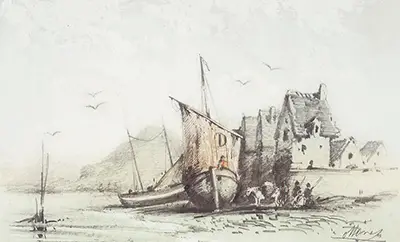In fact, Monet was just 17 years old when he drew The Old Le Pollet, making it a very intriguing early work by a painter who would later become a famous French Impressionist. The title of the work, The Old Le Pollet, refers to a particular quarter of the French city of Dieppe.
It is clear that even from his earliest works of art, Monet was interested in depicting natural and urban phenomena in his native France.
This interest would continue throughout his career, as he turned his attention to various subjects, including Rouen Cathedral (which he painted into a series of oil on canvas works in different times of day) and the coast line of Normandy. Though it is very much rooted in French culture, The Old Le Pollet is now held in the Museum of Fine Art in Boston where it is on public display.
Beyond Monet, other famous draughtsmen include the likes of Gustav Klimt, Pablo Picasso, Michelangelo, Leonardo da Vinci and Rembrandt. Drawing skills are a key attribute for most artists, whatever the main medium of their work. These artists cover a variety of art periods and as such their drawing tools would vary, from graphite to chalk or charcoal.
The medium of The Old Le Pollet is a mix of graphite and watercolour applied to scratchboard. The graphite is used to create bold strokes and clear, defined lines whilst the watercolour wash adds a moody gradient to the whole scene. The wash also gives the sense of a watery harbour, which of course is what Monet is depicting in this work. Monet would also use pastels in other artworks.
Monet used many different media throughout his life to create his paintings, and he never stopped using graphite and charcoal to create little sketches. He often sketched family members in later life, for example about three decades after he drew The Old Le Pollet, Monet sketched his 7 year old sun absorbed in his reading.
The Old Le Pollet has a dynamic and even dramatic quality to it. This is largely due to the sweeping figure of the ship which veers diagonally down towards the centre of the paper with its large sail. However, on the water's edge, we can also make out a few human figures and a donkey or horse accompanying them.
Looking closer at the figures, the viewer could even construct a whole story - why are they there? What is their relationship to each other?
Are they real people that Monet saw as he sat and sketched or has he added them in? The way that these figures are drawn might invite the viewer to draw a comparison between The Old Le Pollet and the political and social cartoon style sketches that were so popular in Europe in the middle of the nineteenth century.
Perhaps The Old Le Pollet would not strictly be described as a wholly or solely Impressionist work of art. However, it does have various Impressionistic elements to it. Most saliently, like most of Monet's famous Impressionist works, The Old Le Pollet is executed 'en plein aire' in a way that conveys a sense of immediacy and emotion.


